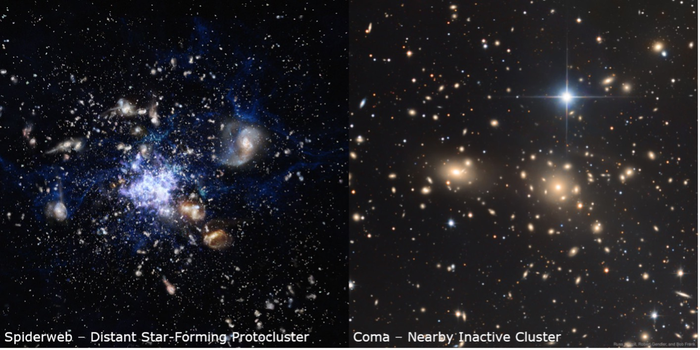A newly discovered growing galactic metropolis, named MAGAZ3NE J095924+022537, reveals an unusual massive cluster of young galaxies forming in the early universe. This protocluster consists of at least 38 member galaxies, and is about 11.8 billion light-years away from Earth. The team used spectroscopic observations from the W. M. Keck Observatory’s Multi-Object Spectrograph for Infrared Exploration, or MOSFIRE, to make detailed measurements of MAGAZ3NE J0959 and precisely quantify its distances.
What they only now saw was the protocluster as it appeared when the universe was less than 2 billion years old. Unlike all of the other protoclusters that have been found at this epoch, many galaxies in MAGAZ3NE J0959 appear to have already stopped forming stars.

Credit: Spiderweb: M. Kornmesser/ESO; Coma: Russ Carroll, Robert Gendler,&Bob Franke/Dan Zowada Memorial Observatory.
At the heart of MAGAZ3NE J0959 is an ultramassive galaxy that has already formed a mass of more than 200 billion suns.
“Why this ultramassive galaxy and so many of its neighbors formed most of their stars and then became inactive when the universe was still so young, in contrast to other known protoclusters from the same time, is a big mystery,” said co-author Benjamin Forrest, Ph.D., of UC Davis. “Why its galaxies are so unlike those in all the other known protoclusters, and so similar to those in Coma, is a complete mystery.”
Since MAGAZ3NE J0959 was discovered from the ground, if the recently-launched James Webb Space Telescope works as hoped, it may reveal other protoclusters like MAGAZ3NE J0959 packed with dead galaxies waiting to be found in the early universe.
“Should such protoclusters be found in large numbers, it would mean that the current paradigm of protocluster formation would require a major revision,” Forrest said. “A new scenario of protoclusters existing in a diversity of states in the early universe would have to be adopted. With many member galaxies quenching in the first two billion years, this would almost certainly pose significant challenges for current models of galaxy simulation.”






Comments